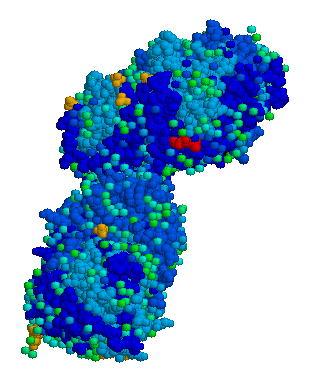Gaucher's disease pathophysiology
|
Gaucher's disease Microchapters |
|
Diagnosis |
|---|
|
Treatment |
|
Case Studies |
|
Gaucher's disease pathophysiology On the Web |
|
American Roentgen Ray Society Images of Gaucher's disease pathophysiology |
|
Risk calculators and risk factors for Gaucher's disease pathophysiology |
Editor-In-Chief: C. Michael Gibson, M.S., M.D. [1]; Associate Editor-In-Chief: Cafer Zorkun, M.D., Ph.D. [2]
Overview
Pathophysiology

The disease is caused by a defect in the housekeeping gene lysosomal gluco-cerebrosidase (also known as β-glucosidase, EC 3.2.1.45, PDB: 1OGS) on the first chromosome (1q21).
The enzyme is a 55.6 KD, 497 amino acids long protein that catalyses the breakdown of glucocerebroside, a cell membrane constituent of red and white blood cells.
The macrophages that clear these cells are unable to eliminate the waste product, which accumulates in fibrils, and turn into Gaucher cells, which appear on light microscopy as appearing to contain crumpled-up paper.
Different mutations in the β-glucosidase determine the remaining activity of the enzyme, and, to a large extent, the phenotype.
In the brain (type II and III), glucocerebroside accumulates due to the turnover of complex lipids during brain development and the formation of the myelin sheath of nerves.
Research suggests that heterozygotes for particular acid β-glucosidase mutations are at an increased risk of Parkinson's disease.[1]
A study of 1525 Gaucher patients in the United States suggested that while cancer risk is not elevated, particular malignancies (non-Hodgkin lymphoma, melanoma and pancreatic cancer) occurred at a 2-3 times higher rate.[2]
Type 1 Gaucher disease is the most common form of this condition. Type 1 is also called non-neuronopathic Gaucher disease because the brain and spinal cord (the central nervous system) are usually not affected. The features of this condition range from mild to severe and may appear anytime from childhood to adulthood. Major signs and symptoms include enlargement of the liver and spleen (hepatosplenomegaly), a low number of red blood cells (anemia), easy bruising caused by a decrease in blood platelets (thrombocytopenia), lung disease, and bone abnormalities such as bone pain, fractures, and arthritis.
Types 2 and 3 Gaucher disease are known as neuronopathic forms of the disorder because they are characterized by problems that affect the central nervous system. In addition to the signs and symptoms described above, these conditions can cause abnormal eye movements, seizures, and brain damage. Type 2 Gaucher disease usually causes life-threatening medical problems beginning in infancy. Type 3 Gaucher disease also affects the nervous system, but tends to progress more slowly than type 2.
The most severe type of Gaucher disease is called the perinatal lethal form. This condition causes severe or life-threatening complications starting before birth or in infancy. Features of the perinatal lethal form can include extensive swelling caused by fluid accumulation before birth (hydrops fetalis); dry, scaly skin (ichthyosis) or other skin abnormalities; hepatosplenomegaly; distinctive facial features; and serious neurological problems. As its name indicates, most infants with the perinatal lethal form of Gaucher disease survive for only a few days after birth.
Another form of Gaucher disease is known as the cardiovascular type because it primarily affects the heart, causing the heart valves to harden (calcify). People with the cardiovascular form of Gaucher disease may also have eye abnormalities, bone disease, and mild enlargement of the spleen (splenomegaly).
Genetics
The three types of Gaucher's disease are inherited in an autosomal recessive fashion. Both parents must be carriers in order for a child to be affected. If both parents are carriers, there is a one in four, or 25%, chance with each pregnancy for an affected child. Genetic counseling and genetic testing is recommended for families who may be carriers of mutations.
Mutations in the GBA gene cause Gaucher disease. The GBA gene provides instructions for making an enzyme called beta-glucocerebrosidase. This enzyme breaks down a fatty substance called glucocerebroside into a sugar (glucose) and a simpler fat molecule (ceramide). Mutations in the GBA gene greatly reduce or eliminate the activity of beta-glucocerebrosidase. Without enough of this enzyme, glucocerebroside and related substances can build up to toxic levels within cells. Tissues and organs are damaged by the abnormal accumulation and storage of these substances, causing the characteristic features of Gaucher disease.
Each type has been linked to particular mutations. In all, there are about 80 known mutations, grouped into three main types:[3]
- Type I (N370S homozygote, the most common, also called the "non-neuropathic" type) occurs mainly (100x the general populace) in Ashkenazi Jews. It is mainly diagnosed in late childhood or early adulthood. Life expectancy is mildly decreased. There are no neurological symptoms. Dor Yeshorim, a non-profit testing organisation, therefore only tests patients on request.
- Type II (1 or 2 alleles L444P) is characterized by neurological problems in small children. The enzyme is hardly released into the lysosomes. Prognosis is dismal: most die before reaching the third birthday.
- Type III (also 1-2 copies of L444P, possibly delayed by protective polymorphisms) occurs in Swedish patients from the Norrbotten region. This group develops the disease somewhat later, but most die before their 30th birthday.
Diaz et al suggest that the Gaucher-causing mutations entered the Ashkenazi Jewish gene pool in the early Middle Ages (48-55 generations ago).[4]
References
- ↑ Aharon-Peretz J, Rosenbaum H, Gershoni-Baruch R (2004). "Mutations in the glucocerebrosidase gene and Parkinson's disease in Ashkenazi Jews". N. Engl. J. Med. 351 (19): 1972–7. doi:10.1056/NEJMoa033277. PMID 15525722.
- ↑ Landgren O, Turesson I, Gridley G, Caporaso NE (2007). "Risk of Malignant Disease Among 1525 Adult Male US Veterans With Gaucher Disease". 167 (11): 1189–1194. doi:10.1001/archinte.167.11.1189. PMID 17563029.
- ↑ Online Mendelian Inheritance in Man (OMIM) 606463
- ↑ Diaz GA, Gelb BD, Risch N; et al. (2000). "Gaucher disease: the origins of the Ashkenazi Jewish N370S and 84GG acid beta-glucosidase mutations". Am. J. Hum. Genet. 66 (6): 1821–32. PMID 10777718.